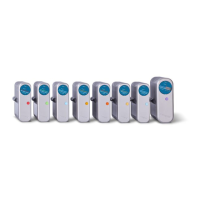ENGINEERING MANUAL OF AUTOMATIC CONTROL
BUILDING AIRFLOW SYSTEM CONTROL APPLICATIONS
282
DUCT STATIC
PRESSURE SENSOR
SUPPLY
FAN
C2622
STATIC PRESSURE
REFERENCE
RETURN
FAN
AIR TERMINAL
UNITS
CONTROLLER
RETURN
FAN
CONTROLLER
BUILDING SPACE
STATIC PRESSURE
OUTDOOR STATIC
PRESSURE
C2623
Fig. 27. Open Loop Control.
Open loop control is often acceptable on small systems more
tolerant of minimum outdoor air and building pressurization
variations. Since open loop control does not sense or control
return airflow, changes caused by the return side dampering
and exhaust fan exfiltration change the minimum airflow and
building pressurization. Systems with low airflow turndowns
also are more suitable for open loop control. As a rule,
turndowns should not exceed 50 percent.
In a control sequence where the outdoor air damper is closed
(e.g., night cycle or morning warm-up), open loop control
should not be used. Excessive negative pressurization will occur
in the duct between the return and supply fans.
Direct Building Static Control
In direct building static control, the return fan responds directly
to the building space static pressure referenced to the static pressure
outside of the building (Fig. 28). The location of the building
space static pressure sensor should be away from doors opening
to the outside, elevator lobbies, and some confined areas. Usually
a hallway on an upper floor is suitable. The outdoor static pressure
sensor must avoid wind effects and be at least 5 meters above the
building to avoid static pressure effects caused by wind. Due to
stack effect, this technique should not be used in tall buildings
with open spaces or atriums, unless the building has been
partitioned vertically. This technique should use proportional plus
integral control with a wide throttling range for stable, accurate,
and responsive operation.
C2624
CONTROLLER
FLOW
MEASURING
STATIONS
RETURN
FAN
SUPPLY
FAN
Since building static is controlled directly, the pressure remains
constant even when exhaust fan airflow changes. Minimum
outdoor airflow varies with changes in exhaust fan airflow and
building infiltration/exfiltration. In a control sequence where the
outdoor air damper is closed, the building static must be reset to
zero and all exhaust fans should be turned off.
Airflow Tracking Control
In airflow tracking (Fig. 29) control, the return fan airflow is
reset based on the relationship between supply and exhaust fan
airflows. That relationship is usually a fixed difference between
the supply total airflow and return plus exhaust total airflow, but
it can also be a percentage of supply total airflow. When duct
layout prevents measuring of total airflow from one flow station,
measurements in multiple ducts are totaled. This technique is
usually higher cost, especially when multiple flow stations are
required. Airflow tracking control and direct building static control
are preferable to open loop control. Proportional plus integral
control is necessary for accurate operation.
Fig. 29. Airflow Tracking Control for Return Fan.
Minimum outdoor airflow should be maintained at a constant
level, independent of exhaust fan airflow and changes in
building infiltration/exfiltration. Building space pressurization
varies only when building infiltration/exfiltration changes.
Exhaust fan airflow must reset the return fan airflow for building
pressurization to be independent of exhaust fans. In a control
sequence where the outdoor air damper is closed, the differential
between supply airflow and return airflow must be reset to zero
and all exhaust fans should be turned off.
Refer to the Air Handling System Control Applications
section for an example of a VAV AHU WITH RETURN FAN
AND FLOW TRACKING CONTROL.
Fig. 28. Direct Building Static Control.

